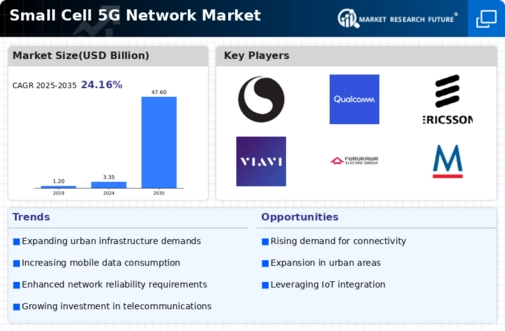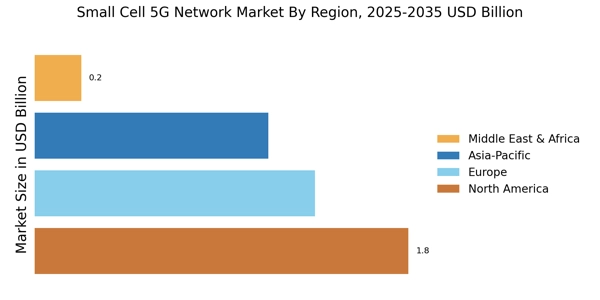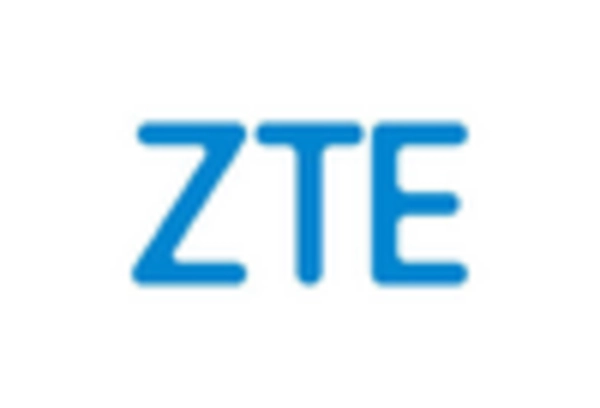Growing Adoption of IoT Devices
The Small Cell 5G Network Market is significantly impacted by the growing adoption of Internet of Things (IoT) devices across various sectors. As industries such as healthcare, manufacturing, and transportation increasingly integrate IoT solutions, the demand for reliable and high-speed connectivity becomes critical. Small cells are uniquely positioned to support the dense connectivity requirements of IoT ecosystems, enabling real-time data transmission and communication between devices. It is estimated that by 2025, there will be over 30 billion connected IoT devices, creating a substantial need for enhanced network infrastructure. This trend suggests that the Small Cell 5G Network Market will continue to expand as service providers seek to accommodate the connectivity needs of these devices. The interplay between IoT growth and small cell deployment is likely to drive innovation and investment in the telecommunications sector.
Support for Smart City Initiatives
The Small Cell 5G Network Market is significantly influenced by the ongoing development of smart city initiatives. Urban planners and local governments are increasingly recognizing the potential of 5G technology to enhance city services, improve public safety, and optimize resource management. Small cells are essential in this context, as they facilitate the deployment of Internet of Things (IoT) devices that monitor traffic, manage energy consumption, and enhance public transportation systems. As cities aim to become more connected and efficient, the integration of small cell networks is expected to accelerate. Reports suggest that investments in smart city technologies could exceed 1 trillion by 2025, further driving the demand for small cell infrastructure. This alignment between urban development and telecommunications infrastructure underscores the pivotal role of the Small Cell 5G Network Market in shaping the future of urban living.
Regulatory Support and Policy Frameworks
The Small Cell 5G Network Market is benefiting from favorable regulatory support and evolving policy frameworks. Governments are increasingly recognizing the importance of 5G technology in driving economic growth and innovation. As a result, many countries are implementing policies that facilitate the deployment of small cell networks, including streamlined permitting processes and reduced fees for infrastructure installation. This regulatory environment is crucial for accelerating the rollout of small cells, which are essential for achieving widespread 5G coverage. For instance, recent legislative measures in various regions have aimed to simplify the approval process for small cell installations, potentially reducing deployment times by up to 50%. Such initiatives not only encourage investment in the Small Cell 5G Network Market but also foster competition among service providers, ultimately benefiting consumers through improved services and pricing.
Enhanced Network Reliability and Coverage
The Small Cell 5G Network Market is poised for growth due to the increasing emphasis on network reliability and coverage. As mobile users demand uninterrupted service, particularly in densely populated areas, small cells offer a solution by filling coverage gaps and enhancing signal strength. The deployment of small cells can lead to a 30% improvement in network performance, as they reduce the distance between the user and the network source. This is particularly relevant in urban environments where traditional macro cell towers may struggle to provide adequate coverage. Furthermore, the integration of small cells into existing networks allows operators to optimize their infrastructure without the need for extensive new builds. As a result, the Small Cell 5G Network Market is likely to see heightened investment from telecommunications companies seeking to enhance their service offerings and meet consumer expectations.
Increased Demand for High-Speed Connectivity
The Small Cell 5G Network Market is experiencing a surge in demand for high-speed connectivity, driven by the proliferation of data-intensive applications. As consumers and businesses increasingly rely on seamless internet access for activities such as streaming, gaming, and remote work, the need for robust network infrastructure becomes paramount. According to recent data, the number of connected devices is projected to reach 75 billion by 2025, necessitating enhanced network capabilities. Small cells, with their ability to provide localized coverage and offload traffic from macro cells, are well-positioned to meet this demand. This trend indicates a shift towards more decentralized network architectures, where small cells play a critical role in ensuring that users experience minimal latency and maximum bandwidth. Consequently, the growth of the Small Cell 5G Network Market is likely to continue as service providers invest in expanding their small cell deployments.


















Leave a Comment